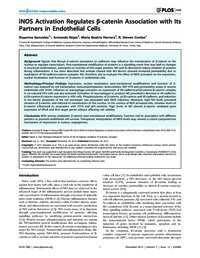iNOS activation regulates b-catenin association with its partners in endothelial cells
Fecha
2012Resumen
Background: Signals that disrupt b-catenin association to cadherins may influence the translocation of b-catenin to the
nucleus to regulate transcription. Post-translational modification of proteins is a signalling event that may lead to changes
in structural conformation, association or function of the target proteins. NO and its derivatives induce nitration of proteins
during inflammation. It has been described that animals treated with NO donors showed increased permeability due to
modulation of VE-cadherin/catenin complex. We, therefore, aim to evaluate the effect of iNOS activation on the expression,
nuclear localisation and function of b-catenin in endothelial cells.
Methodology/Principal Findings: Expression, nuclear localisation, post-translational modifications and function of bcatenin
was analysed by cell fractionation, immunoprecipitation, immunoblots, QRT-PCR and permeability assays in murine
endothelial cells (H5V). Influence of macrophage activation on expression of VE-cadherin/p120-catenin/b-catenin complex
in co-cultured H5V cells was also assessed. Activation of macrophages to produce NO provoked a decrease in VE-cadherin/
p120-catenin/b-catenin expression in H5V cells. Phosphorylation of b-catenin, p120-catenin and VE-cadherin, and reduction
in the barrier properties of the cell monolayer was associated with iNOS induction. Moreover, high NO levels provoked
nitration of b-catenin, and induced its translocation to the nucleus. In the nucleus of NOS activated cells, nitration levels of
b-catenin influenced its association with TCF4 and p65 proteins. High levels of NO altered b-catenin mediated gene
expression of NFkB and Wnt target genes without affecting cell viability.
Conclusions: NOS activity modulates b-catenin post-translational modifications, function and its association with different
partners to promote endothelial cell survival. Therapeutic manipulation of iNOS levels may remove a critical cytoprotective
mechanism of importance in tumour angiogenesis.
Fuente
PLoS ONE, 7(12), e52964Identificador DOI
doi.org/10.1371/journal.pone.0052964Colecciones
La publicación tiene asociados los siguientes ficheros de licencia:



